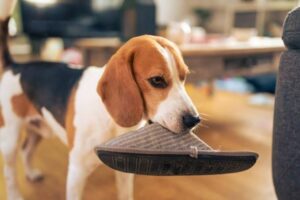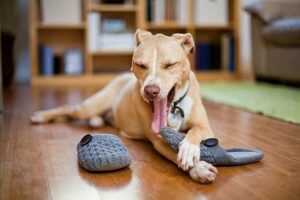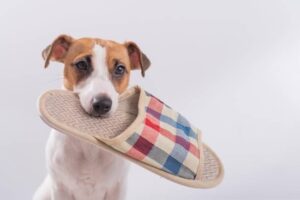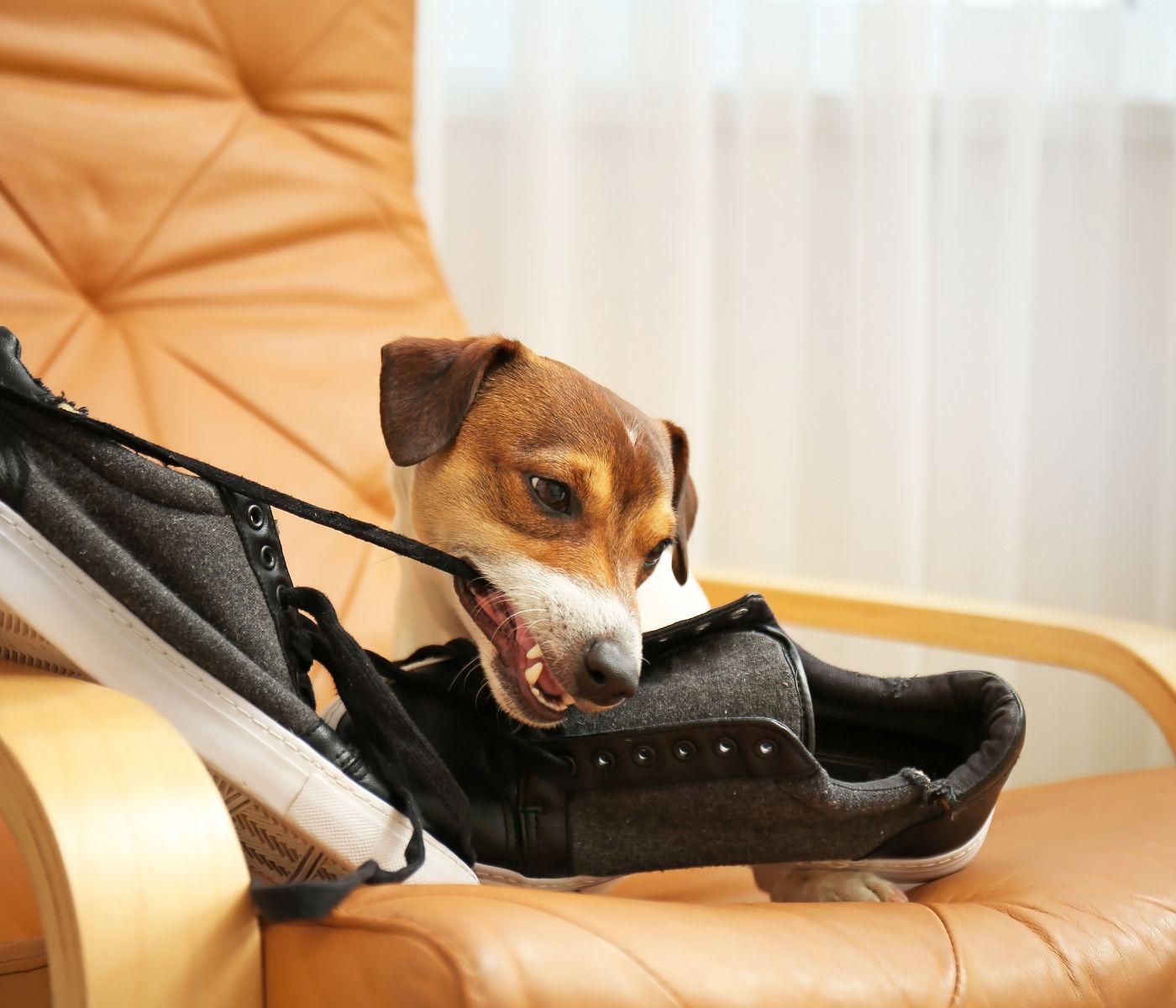Dogs are known for their playful and mischievous behavior, and one expected behavior that owners may find frustrating is their chewing on shoes.
Whether it’s a beloved pair of sneakers or an expensive pair of leather shoes, dogs seem to have a particular fondness for chewing on shoes.
This behavior can be frustrating and costly, but it’s essential to understand why dogs like shoes so much and how to prevent it.
It’s important to remember that chewing is a natural behavior for dogs. It serves various purposes, such as exercise for their jaws and teeth, relief from discomfort during teething, and entertainment when bored.
By examining the different factors contributing to this behavior, such as the smell, texture, and accessibility of shoes, owners can better understand why their dogs are drawn to shoes.
With the proper training and management techniques, such as providing appropriate chew toys, positive reinforcement, keeping shoes out of reach, and supervising their behavior, owners can help their dogs overcome their shoe-chewing tendencies and redirect them to more appropriate chew items.
Understanding a Dog’s Chewing Behavior:

1.Natural Instincts:
Chewing is a natural behavior for dogs, and it helps them to exercise their jaws and teeth.
This instinct to chew can be traced back to their ancestors, who chewed on bones and rawhide to clean their teeth and maintain their oral health.
This behavior is also part of a dog’s drive to explore the world and learn about its environment.
Chewing helps them to experience the texture, temperature, and scent of objects in their mouths, which assists them in making decisions about what’s edible (or not) when they’re hungry.
2. Teething:
Young dogs, especially puppies, often chew on anything they can get their teeth on as they grow and develop.
This is because teething can cause discomfort, and chewing helps relieve the pressure and discomfort on their gums.
3. Boredom:
When dogs are bored, they often chew on anything they can find to keep themselves entertained.
Chewing is a way for dogs to expend energy and pass the time when they are not receiving enough mental and physical stimulation.
4. Stress:
Dogs that are stressed or anxious can often be seen chewing on things in their environment, including furniture and other items.
Chewing is a way for dogs to relieve stress and anxiety by providing them with something to do that provides an outlet for their energy.
5. Attention:
Dogs looking for attention will often chew on things to get their owners’ attention.
This can result from boredom, but it can also be a way for dogs to get some human interaction and playtime with their owners, who may not have enough time or energy to provide adequate attention.
Shoes as a Target for Chewing:

1.Smell:
Dogs have an incredible sense of smell and are often attracted to the scent of their owner’s shoes.
The smell of feet and sweat can be irresistible to dogs, making shoes a prime target for chewing.
2. Comfort:
Shoes can also be a target for chewing because they are comfortable for dogs.
Many shoes are made with soft and flexible materials, making them an excellent place for dogs to curl up and nap.
3. Texture:
The texture of shoes can also be attractive to dogs. Shoes made from soft materials, such as leather or suede, can be irresistible to chew on.
Additionally, shoes with laces or strings can provide a fun and interactive experience for dogs.
4. Accessibility:
Shoes are often left out in the open and are easily accessible to dogs. This makes them an easy target for dogs looking for something to chew on.
In addition, shoes are often made from materials appealing to dogs. Leather and suede are soft and flexible, while laces can provide a fun experience for dogs who like to play with objects.
Prevention and Training:

1.Providing Appropriate Chew Toys:
One way to prevent dogs from chewing on shoes is by providing them with appropriate chew toys.
These toys can be made of rubber, nylon, or other durable materials and can be designed to mimic bones or other items that dogs might find interesting to chew on.
When selecting a chew toy, remember that dogs prefer toys about the size of their mouth.
For example, if your dog has small or medium-sized jaws, a large rubber bone may be too big for them to enjoy.
2. Training and Positive Reinforcement:
Training and positive reinforcement can also prevent dogs from chewing on shoes. By teaching dogs, the commands “leave it” or “drop it,” owners can help them understand what is and is not appropriate to chew on.
Positive reinforcement techniques, such as treats and praise, can encourage dogs to chew on their toys instead of shoes.
3. Indoor Play:
If you have a puppy or young dog, providing them with plenty of indoor playtime is essential. For example, owners can place toys strategically throughout the home and encourage their dogs to interact with them.
This will help prevent dogs from chewing on shoes that may be lying around the house instead of being used for playtime.
4. Keeping Shoes Out of Reach:
Another way to prevent dogs from chewing on shoes is to keep them out of reach.
This can be done by keeping shoes in a closet or on a high shelf where dogs can’t access them. If shoes must be left out in the open, owners can try to place them in a closed closet or behind a gate or barrier.
5. Supervision and Monitoring:
Finally, owners can prevent dogs from chewing on shoes by supervising and monitoring them. This can be especially important for young dogs or puppies, which may be more prone to chewing on inappropriate items.
By watching their behavior and redirecting them to appropriate chew toys, owners can help prevent the development of this destructive behavior.
FAQs:
Q: Is chewing on shoes harmful to dogs?
A: Yes, chewing on shoes can be harmful to dogs as some shoes may contain toxic chemicals, adhesives, or other harmful substances that can be harmful if ingested.
Additionally, chewing on shoes can also cause damage to the shoes and create a choking hazard for the dog.
Q: How can I redirect my dog’s chewing behavior to more appropriate items?
A: To redirect a dog’s chewing behavior, owners can provide them with appropriate chew toys, offer positive reinforcement for good behavior, and supervise them to ensure they’re not chewing on inappropriate items. Owners can also provide mental and physical stimulation through training, exercise, and interactive toys to help keep their dogs entertained and prevent boredom.
Q: What chew toys are appropriate for dogs who like to chew on shoes?
A: Appropriate chew toys for dogs who like to chew on shoes should be made of durable, non-toxic materials, such as rope or rubber, and be safe to chew on.
It’s also essential to provide a variety of chew toys to keep their interest and prevent boredom. Some examples of appropriate chew toys for dogs include rope toys, chew bones, and puzzle toys.
Q: How can I ensure my dog gets enough exercise and mental stimulation to prevent shoe chewing?
A: To ensure that your dog gets enough exercise and mental stimulation, owners can provide daily walks, playtime, and interactive toys. Owners can also enroll their dogs in training classes or consider engaging in dog sports, such as agility, to provide mental and physical stimulation.
Owners can incorporate puzzle toys, hide-and-seek games, and other interactive activities into their daily routines to stimulate their dogs mentally.
Q: Should I scold my dog or physically punish them for chewing on shoes?
A: No, scolding or physically punishing your dog is not an effective way to stop them from chewing on shoes. This can escalate the behavior and cause fear or aggression in dogs. Instead, owners should use positive reinforcement techniques, such as rewarding good behavior and redirecting their chewing to appropriate items, to help change their behavior.
Q: What should I do if my dog continues to chew on shoes despite my best efforts?
A: If your dog continues to chew on shoes despite your best efforts, it may be helpful to seek the advice of a professional dog trainer or veterinary behaviorist. They can help assess your dog’s behavior and provide a personalized training plan to address their needs. Additionally, it’s essential to continue providing appropriate chew toys, positive reinforcement, and supervision to help prevent destructive chewing behavior.
